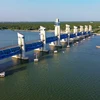Urban development must develop in a manner that takes climate change into account, including more green building, experts said at an international conference held in HCM City on Feb.27.
Speaking at the conference, Olavo Rasquinho, secretary of the Typhoon Committee, an intergovernmental body based in Macau , said ineffective land-use planning, waste management and infrastructure construction would make cities more vulnerable to climate change.
If governments do not take climate-change adaptation seriously, flooding in particular would increase in frequency and intensity, causing damage to property, livelihoods, human health and economies.
Rasquinho pointed to the example of downtown Beijing, where more rain is falling compared to suburban areas because of the number of tall buildings affecting the formation of clouds.
"Urban flooding is not an isolated issue and it should be integrated with urban system or planning," he said, suggesting that cities should engage in international cooperation to increase the managerial capacity of urban planners.
Melissa Susan Merryweather, coordinator of Vietnam Green Building Council, told the conference attendees that architectural models should be chosen according to the kind of climate zone.
"Western architectural prototypes are suitable for northern climates, but are less appropriate in a hot tropical climate," she said.
She urged builders and investors to follow Viet Nam's new LOTUS system, somewhat similar to the LEED standard in the US, which awards points to green construction.
The LOTUS system was set up to reduce power consumption and mitigate carbon output, reduce pollution, adapt to climate change and implement sustainable management.
She said there were a few buildings in Vietnam that had been built according to the LOTUS standards, including UN One Green House in Hanoi , Moc Bai Factory in Tay Ninh and the Solar Panel Factory in HCM City .
Most of the speakers focused on the need for adaptation to climate change by reducing carbon emissions, preserving the natural flow of water and using efficient energy.
This is the fifth annual conference on City Development, which includes discussions on transportation infrastructure development, real estate development and management in developing new urban areas and megacities.
The conference was organised by the Malaysia-based regional office of marcus evans conferences, a global event organiser./.
Speaking at the conference, Olavo Rasquinho, secretary of the Typhoon Committee, an intergovernmental body based in Macau , said ineffective land-use planning, waste management and infrastructure construction would make cities more vulnerable to climate change.
If governments do not take climate-change adaptation seriously, flooding in particular would increase in frequency and intensity, causing damage to property, livelihoods, human health and economies.
Rasquinho pointed to the example of downtown Beijing, where more rain is falling compared to suburban areas because of the number of tall buildings affecting the formation of clouds.
"Urban flooding is not an isolated issue and it should be integrated with urban system or planning," he said, suggesting that cities should engage in international cooperation to increase the managerial capacity of urban planners.
Melissa Susan Merryweather, coordinator of Vietnam Green Building Council, told the conference attendees that architectural models should be chosen according to the kind of climate zone.
"Western architectural prototypes are suitable for northern climates, but are less appropriate in a hot tropical climate," she said.
She urged builders and investors to follow Viet Nam's new LOTUS system, somewhat similar to the LEED standard in the US, which awards points to green construction.
The LOTUS system was set up to reduce power consumption and mitigate carbon output, reduce pollution, adapt to climate change and implement sustainable management.
She said there were a few buildings in Vietnam that had been built according to the LOTUS standards, including UN One Green House in Hanoi , Moc Bai Factory in Tay Ninh and the Solar Panel Factory in HCM City .
Most of the speakers focused on the need for adaptation to climate change by reducing carbon emissions, preserving the natural flow of water and using efficient energy.
This is the fifth annual conference on City Development, which includes discussions on transportation infrastructure development, real estate development and management in developing new urban areas and megacities.
The conference was organised by the Malaysia-based regional office of marcus evans conferences, a global event organiser./.



















